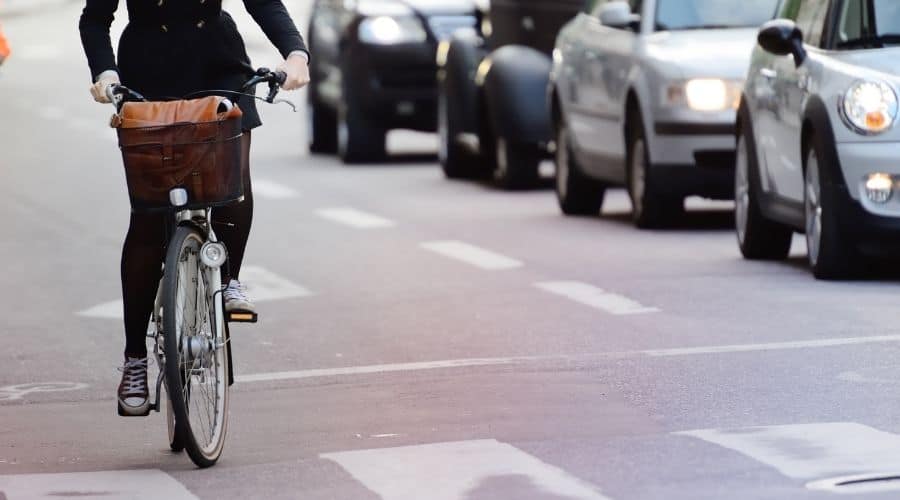Currently, bicyclists have the same rights and responsibilities as automobiles on the road but not the same capabilities. A cyclist often can’t keep up with the speed of traffic, which slows down cars leading to more congested roadways.
No one needs more traffic jams. Why should bicycles not be on the road?
The main reason bicycles should not be on public roads is that roads aren’t built to accommodate cycling traffic. Additionally, bikes are often incapable of maintaining the speed of traffic, which leads to slower overall traffic and contributes to roadway congestion in crowded cities. Cyclists are a danger to motorists and themselves when they ride on public streets.
Recommended Gear
To see all of my up-to-date recommendations for bikes and cycling gear, check out this resource that I made for you!
Table of Contents
7 Reasons Why Bikes Should Not Be Allowed On The Road
It is fair to say that most of the reasons bikes should not be a part of street traffic have to do with the way roads are built, maintained, and used.
Nevertheless, simply being out in traffic can quickly become problematic for both the cyclist and the traffic around them.
Here are my top 7 reasons why bikes should not be allowed on the road:
1 – Bicycles Can’t Keep Up With The Speed Of Traffic
Bicycles can’t match the speed of traffic adequately. An average bike rider travels 12-15 miles per hour.
That’s more than enough for an active school zone or construction area, but not as fast as most residential traffic.
Typically, smaller residential streets have a 20-25 mph speed limit. Few cyclists can maintain that pace for long, and some cannot even reach the minimum residential road speed.
If bikes only rode on residential streets, it might make sense to change things up, but many cyclists also use larger thoroughfares.
Main roads and even highways in some areas have cyclists, and they aren’t moving faster. A slow cyclist can stay to the right, but cars still have to go around them.
Additionally, any bicycle rider wishing to turn left needs to take the lane, which slows the progression of all the traffic behind it.
2 – Inattentional Blindness Is Real And Deadly
Bicyclists have the right to the road, but a relatively small group uses it. Only about thirteen percent of people commute weekly on bicycles compared to the 100s of 1,000,000s of cars.
This results in drivers expecting to see other vehicles on the road rather than bikes, a condition called intentional blindness.
When drivers have inattentional blindness, they quite literally fail to see the cyclists beside them or in front.
The only real solution is to reduce distractions, which isn’t always possible for all drivers.
For example, a driver may have small children in the car, or another vehicle in front of them could be swerving back and forth, causing them to focus on that instead.
3 – Lane And Infrastructure Problems
Roads are not made for bikes and motorized traffic. Some areas have narrow bike lanes, but there’s no standard or requirement.
For now, most cities handle the issue by asking or requiring cyclists to ride as far to the right as possible unless they turn left or move at the speed of traffic.
Until bike lanes are required on a federal level, there will always be roads that lack space for bike safety.
4 – Potholes And Other Common Road Hazards
Unfortunately, the sides of the road are more likely to have hazards like trash and damage, which means the center of the road is the safest place for bikes.
Resultantly, even a federal law requiring bike lanes would need to change the position of those lanes to be genuinely safer for bikes.
Making this switch and requiring central bicycle lanes everywhere would cost hundreds of millions of dollars. Moreover, it would require widening streets in many areas.
5 – Cyclists In Traffic Accidents
Another issue with bike traffic is accidents. In a perfect world where we had central bike lanes and un-distracted drivers, the bikes would still be more likely to be in a fatal accident.
If the only accidents in this perfect world were caused by spontaneous car failures like blown tires, or vehicles stopping for kids and animals that run out into the road, they would still happen.
According to Bay Area Bicycle Law, “The majority of bicycle accidents lead to significant productivity declines and lifelong medical expenses. In 2010, both non-fatal and fatal bicyclist accidents created a productivity reduction of $10 billion, (and) Bicyclists represent 2% of all vehicle accident fatalities. Most who die suffer serious head trauma.”
6 – Bicycles Don’t Handle Weather Well
If it snows where you live, you are probably familiar with tire chains.
When the powder comes down, it makes roads much harder to navigate, so motorists add removable webwork of literal metal chains to their tires to help them get traction as they move forward.
Bicyclists, on the other hand, often do nothing to adapt to the snow other than dress warmer.
Rubber tires don’t grip well, which goes double for narrow, smooth road bike tires. Cyclists can get snow tires.
According to Outdoors, “Studded bike tires provide remarkable traction on snow and ice but don’t fully replicate the regular all-rubber grip you experience on dry asphalt. Think of riding with studs as the biking equivalent of walking on sand-covered ice.”
Rain is also problematic for cyclists. Deep puddles can hide potholes and other dangers.
Moreover, when water hits the road, it causes all the accumulated oil to rise to the surface, making city streets a hazard for bikes.
7 – Bike Riders Break The Law
Every motorized or electric vehicle on the road requires a license except for some low-speed bikes.
Meanwhile, human-powered or manual bikes have no licensing requirements at all. Still, bicycles are required to follow all the traffic laws.
You might think since riding a bike is highly dangerous, riders would be more careful, but many people perceive bike riders as more willing to break traffic laws and less likely to get in trouble for it.
When a cyclist violates the law, it draws a lot of scrutiny. In reality, studies show cyclists are equal or less likely to break a road law.
However, the idea that bike riders are less likely to get in trouble for their infections holds some weight.
Helpful Tips To Know About Why Bicycles Should Not Be On The Road
There are many good reasons why bicycles should not be on the road. Not the least of which is that roads are not set up to accommodate bikes.
Even bike lanes are placed in the worst spot for cyclists to use the road.
Here are more helpful tips to know about why bicycles should not be on the road.
- If bicycles are vehicles and subject to the same laws, they should be licensed to ride on public roads just like drivers. If bikes required road licenses like other vehicles there would be far fewer child bicycle accidents because kids would be less likely to be out on the public streets with their bikes.
- There are ways to make your bike safer on the road such as adding more nighttime lights and reflective tape or paint so cars can see you more easily.
- Traffic jams are caused by drivers who have to hit the brakes in the middle of busy roads. While not all of these are caused by a bike turning left slowly, or a cyclist swerving to avoid potholes, some certainly are. Check out this video from Scientific American to see why slowing traffic is a problem.
Final Thoughts
Whether you are all for bicycles on the road or against them, there are compelling arguments to show that it’s not always a good idea.
Having bikes and motor vehicles share the road is dangerous to both, and it causes traffic jams. Worse still, car accidents involving bicycles are often fatal or debilitating.
Bikes aren’t held to the same standards, despite what the laws say, and they can’t lose their license to ride even if they cause repeated significant problems and damage because there is no license.
Most of all, though, it’s an infrastructure issue. Motorways are not built to accommodate bicycles.

